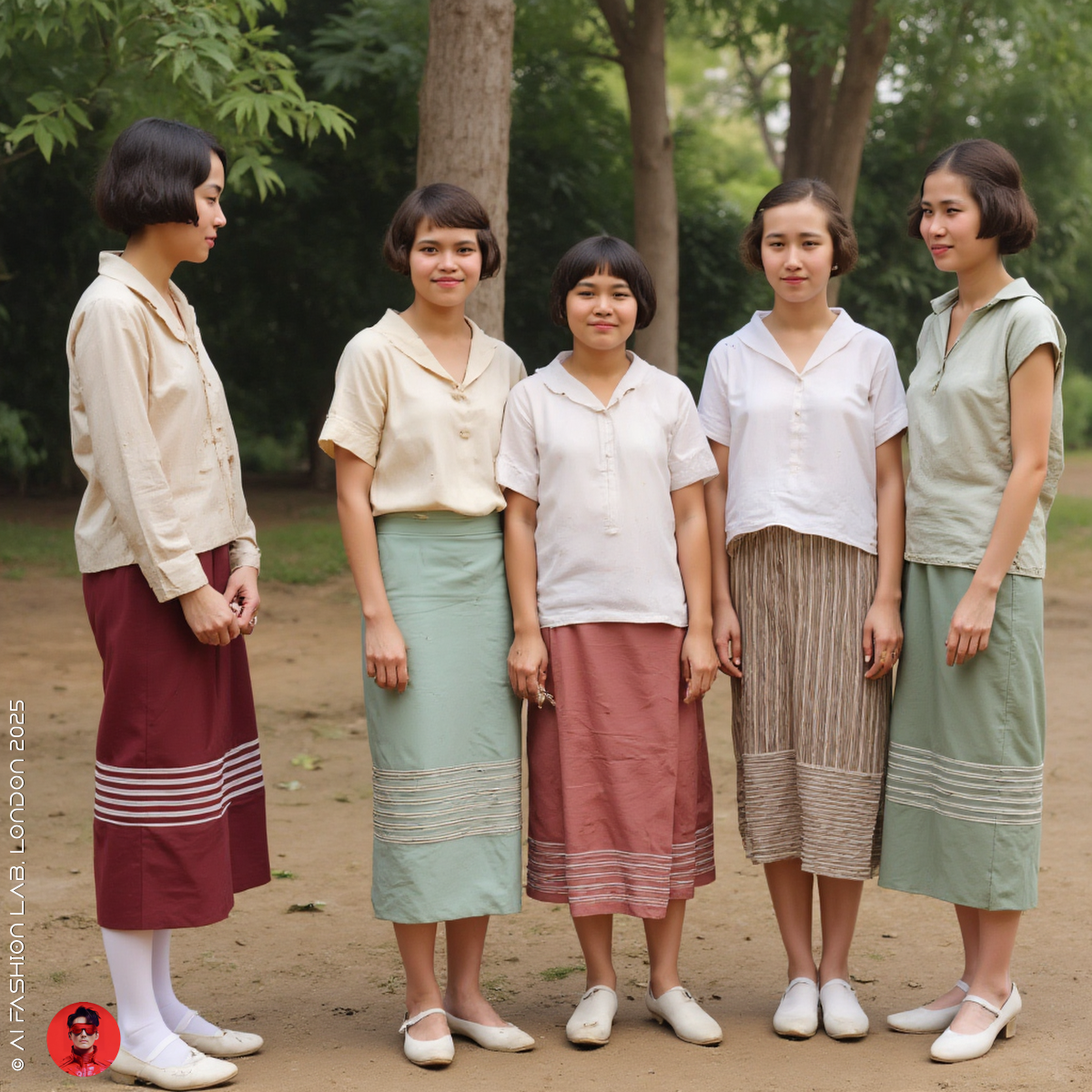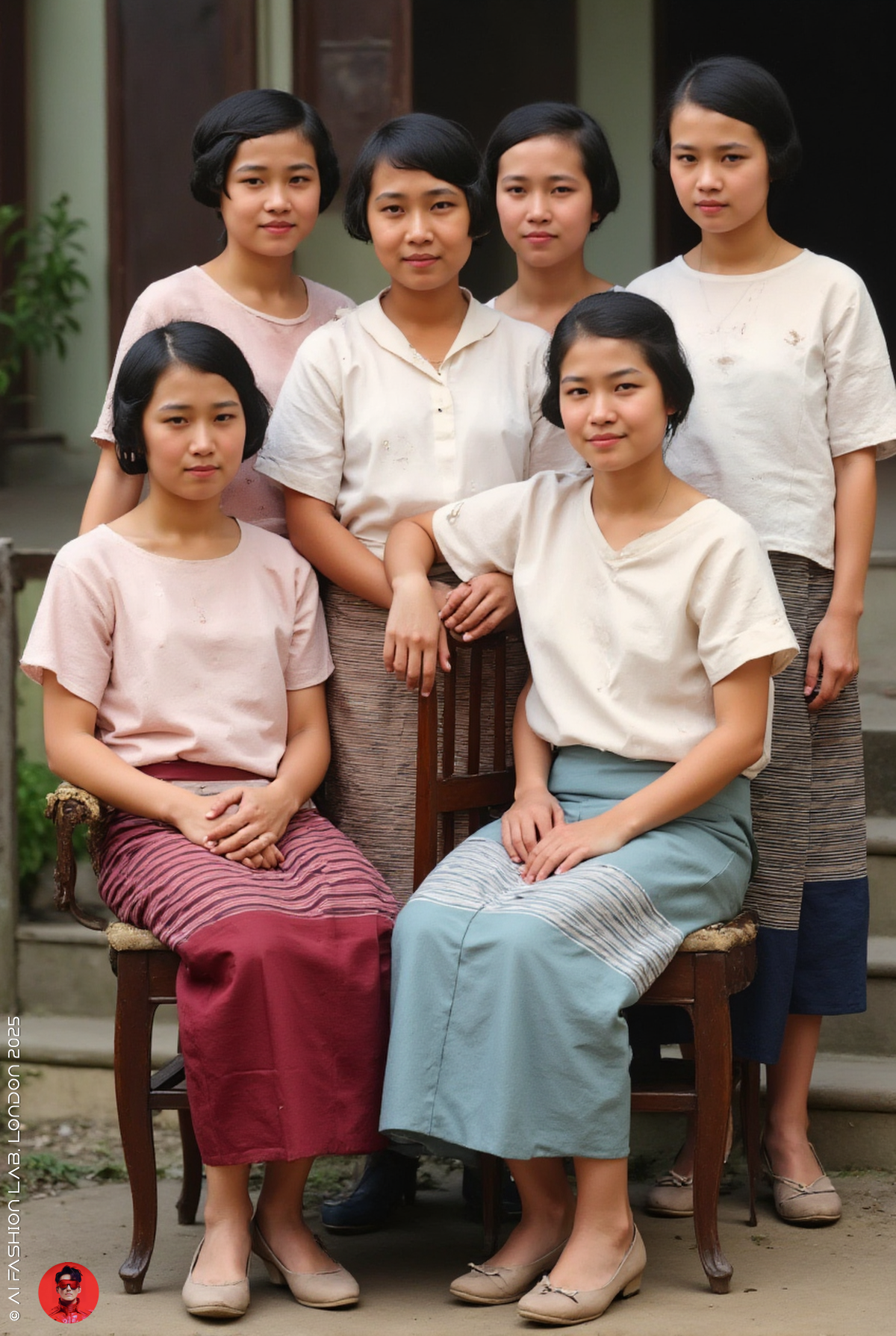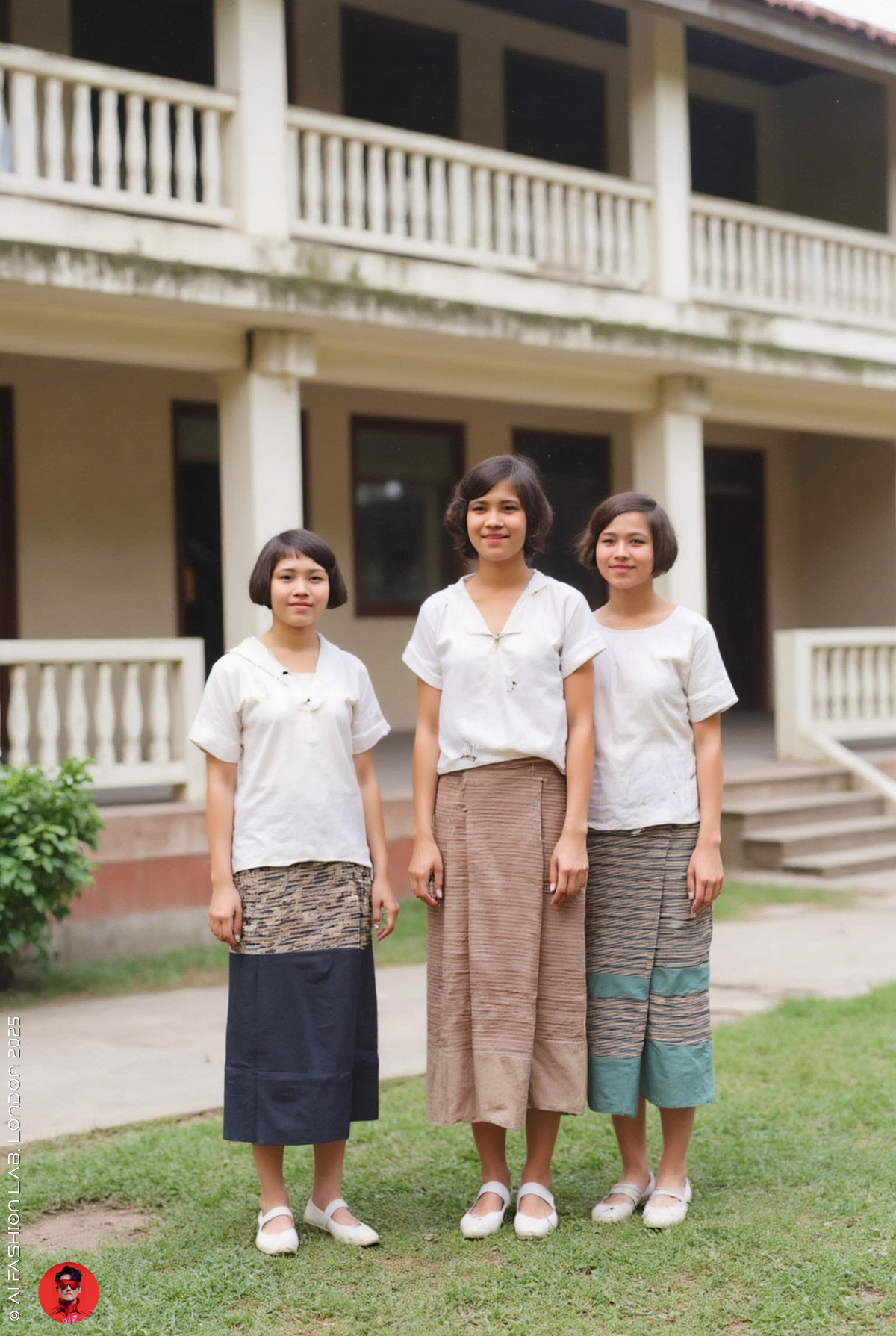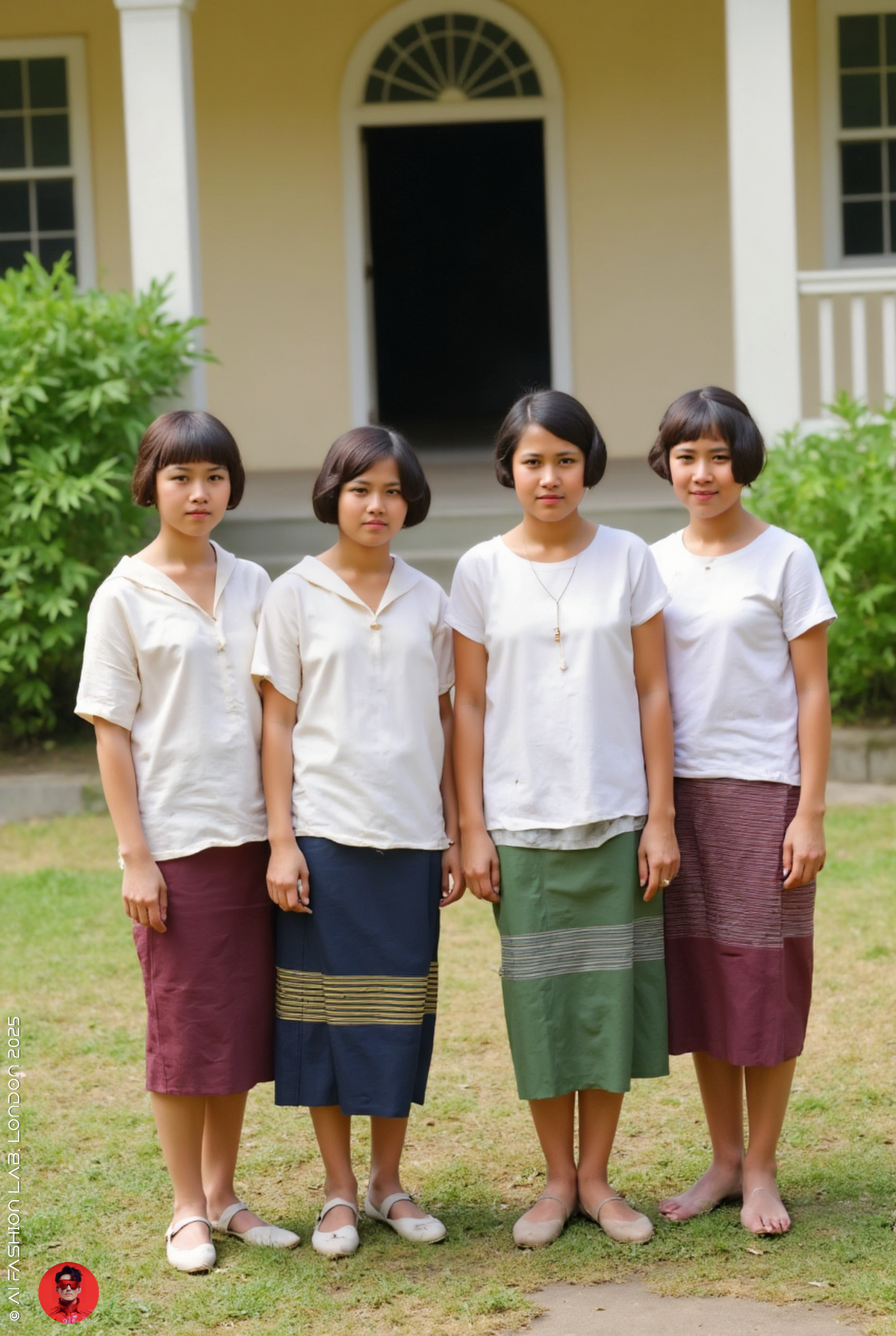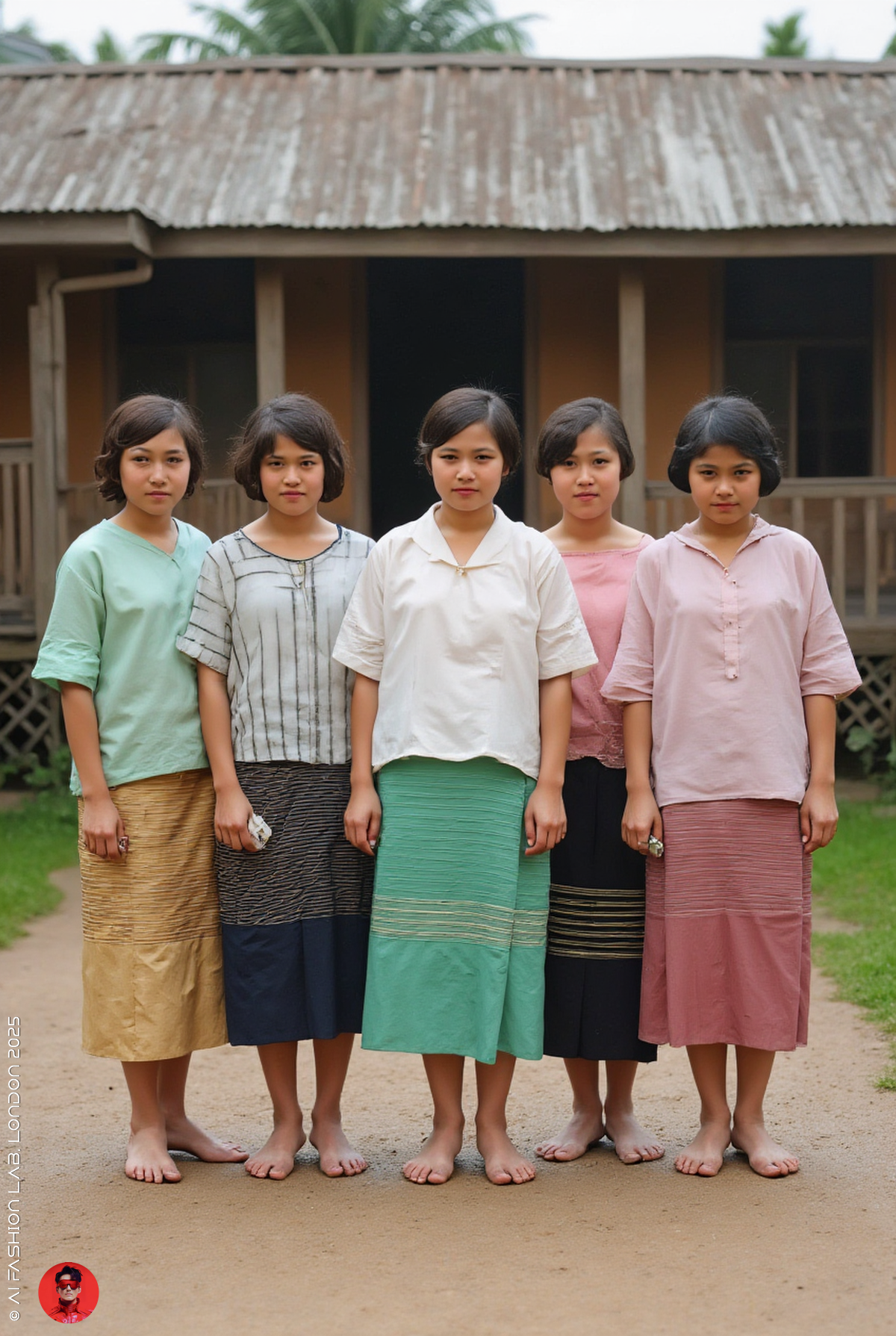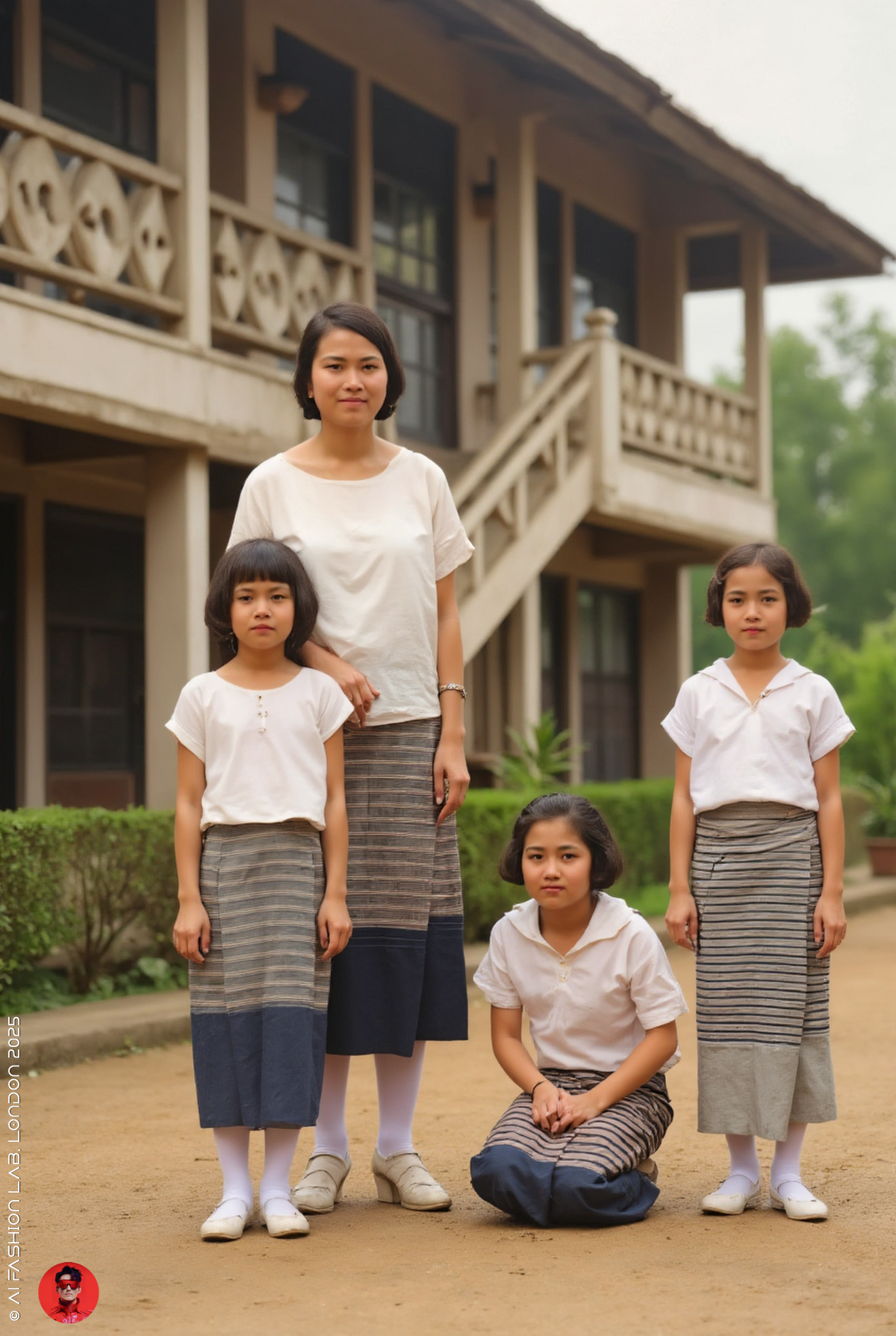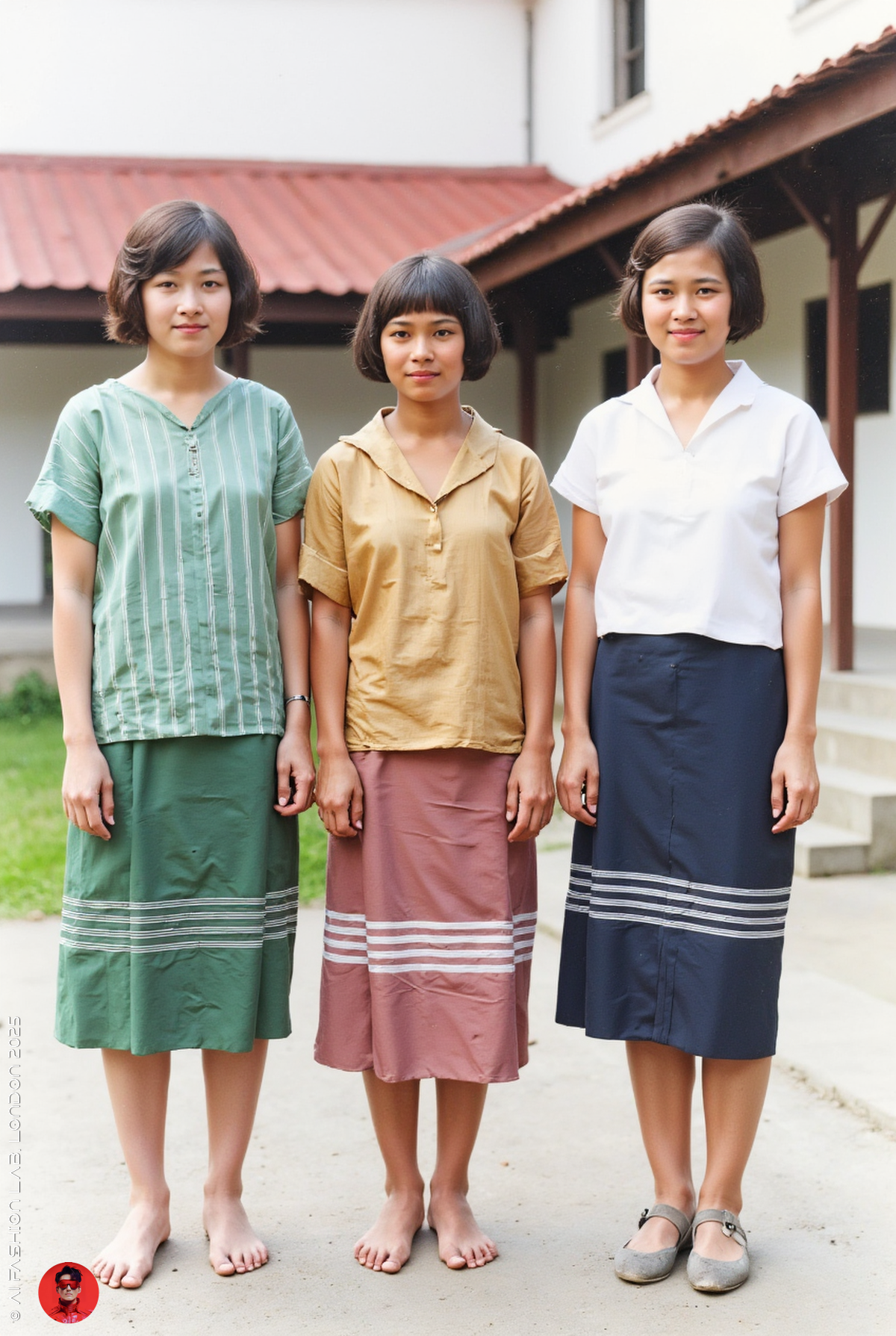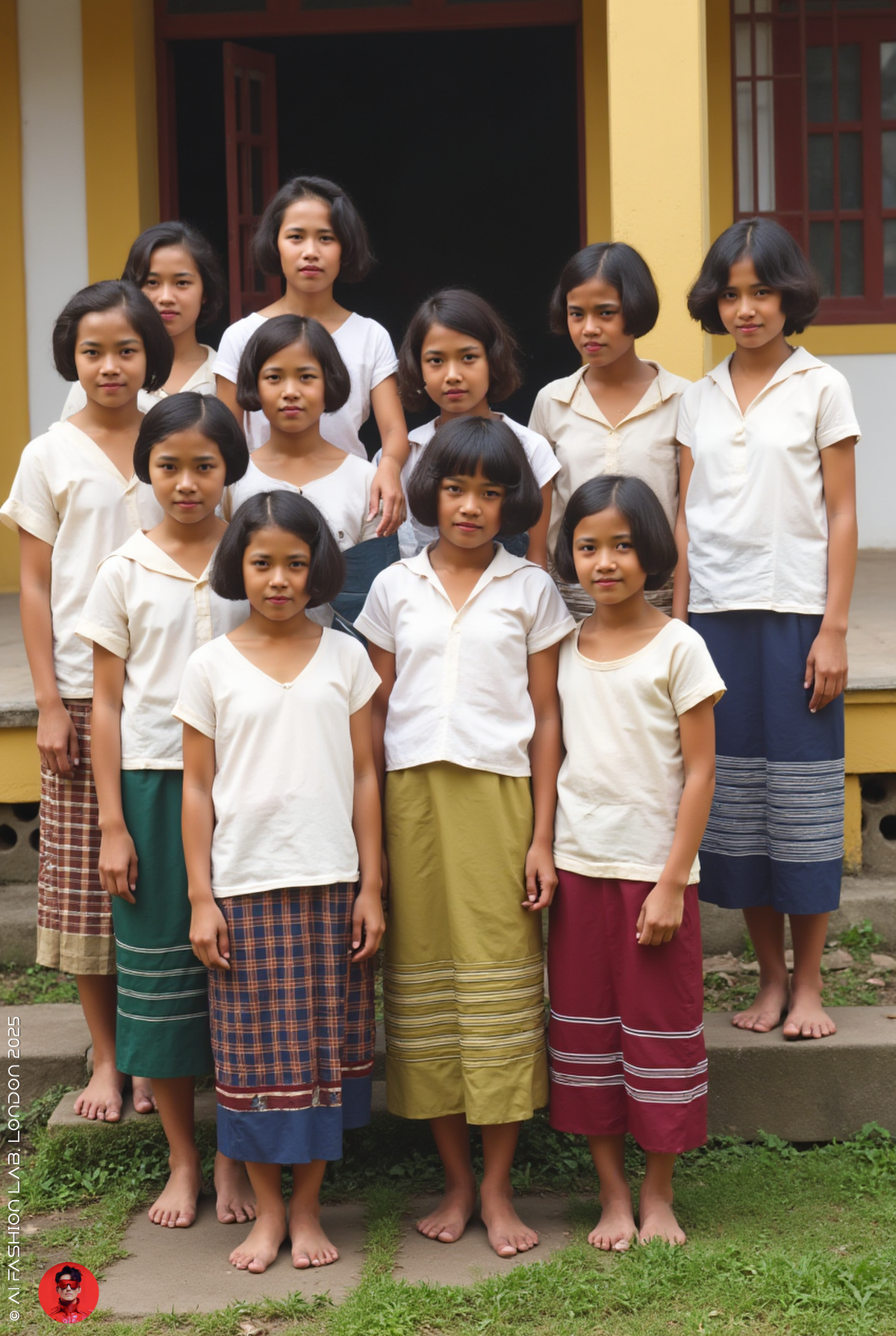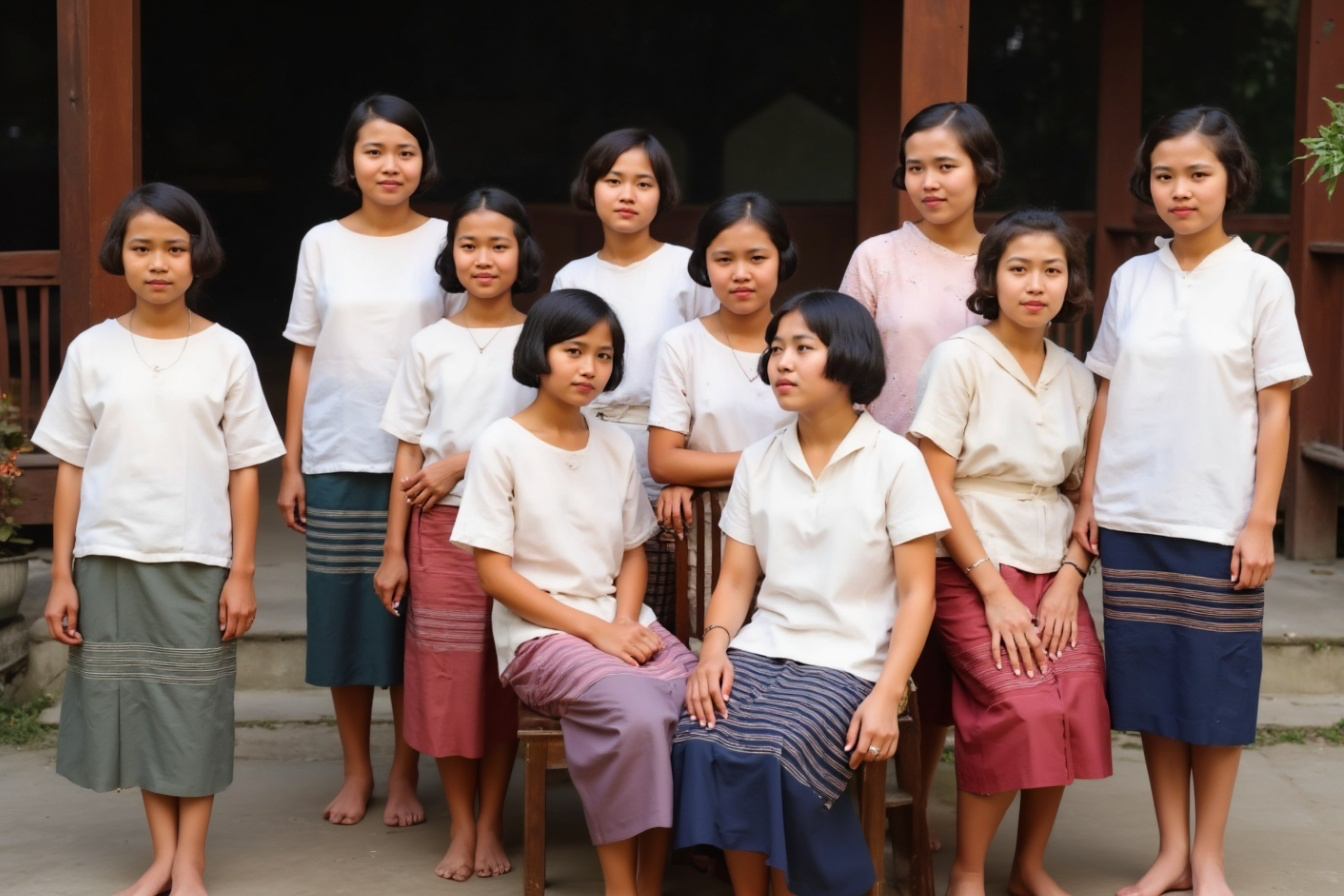โรงเรียนแห่งแรกของล้านนา โรงเรียนพระราชชายา : บทคารวะด้วยภาพที่สร้างสรรค์จาก AI
โรงเรียนแห่งแรกของล้านนา โรงเรียนพระราชชายา : บทคารวะด้วยภาพที่สร้างสรรค์จาก AI
(AI Creation of Historical Photographs from Rachachaya School, the First Girls’ School in Lanna)
ผลงานภาพชุดนี้เกิดจากแรงบันดาลใจที่ได้รับจากโพสต์ของศูนย์มรดกเมืองเทศบาลนครเชียงใหม่ (ลงวันที่ 16 มกราคม) ซึ่งบอกเล่าเรื่องราวการก่อตั้งโรงเรียนหญิงแห่งแรกในดินแดนล้านนา เมื่อปี พ.ศ. 2418 แม่ครูหลวงโซเฟีย บุตรีของ ดร.แดน บีช บรัดเลย์ และมิชชันนารีหญิงผู้มีความรู้ ได้เปลี่ยนบ้านพักของตนริมแม่น้ำปิงให้กลายเป็นสถานศึกษา ซึ่งกลายเป็นรากฐานของการศึกษาสมัยใหม่สำหรับสตรีในเชียงใหม่ โรงเรียนแห่งนี้ได้รับการสนับสนุนจากเจ้านายฝ่ายเหนือ อาทิ เจ้าดารารัศมี และพระบาทสมเด็จพระจุลจอมเกล้าเจ้าอยู่หัว จนต่อมาได้พัฒนาเป็นโรงเรียนดาราวิทยาลัยในปัจจุบัน
คอลเลกชันภาพนี้นำเสนอการสร้างสรรค์ภาพที่เสมือนการบันทึกเรื่องราวของ โรงเรียนพระราชชายา โรงเรียนหญิงแห่งแรกในเชียงใหม่ ซึ่งถือเป็นหมุดหมายสำคัญของประวัติศาสตร์การศึกษาสตรีในดินแดนล้านนา โดยถ่ายทอดเรื่องราวผ่านการตีความในแง่มุมของศิลปะ ซึ่งแม้อาจมิได้ตรงตามประวัติศาสตร์ทั้งหมด แต่ก็มีเจตนาเพื่อสดุดีเกียรติภูมิ จิตวิญญาณ และบทบาทของสตรีและนักเรียนผู้บุกเบิกเหล่านั้น ผู้ซึ่งเปลี่ยนแปลงสังคมล้านนาด้วยพลังแห่งการศึกษาและความรู้
ในยุคเริ่มต้น โรงเรียนแห่งนี้ยังไม่มีเครื่องแบบนักเรียนอย่างเป็นทางการ นักเรียนหญิงแต่งกายด้วยเสื้อผ้าเรียบง่ายตามวิถีพื้นเมือง ต่อมาเมื่อโรงเรียนเติบโตขึ้นตามยุคสมัย ก็ได้มีการกำหนดชุดนักเรียนเป็นเสื้อเชิ้ตสีขาวและกระโปรงจีบสีแดง พร้อมรองเท้าสีขาวสำหรับนักเรียนหญิง ปัจจุบันโรงเรียนดาราวิทยาลัยเปิดรับนักเรียนทั้งหญิงและชาย และยังคงยึดมั่นในพันธกิจด้านการศึกษาที่ส่งเสริมทั้งสติปัญญา คุณธรรม และศักดิ์ศรีความเป็นมนุษย์ตามแบบอย่างของผู้บุกเบิกในอดีต
บทความต้นฉบับครับ จากโพสต์ของศูนย์มรดกเมืองเทศบาลนครเชียงใหม่ (ลงวันที่ 16 มกราคม)
ภาพเก่าเล่าเรื่อง : โรงเรียนแห่งแรกของล้านนา
The First School of Lanna
A Journey Through Historical Photos
---
แรกเริ่มของการรวบรวมเด็กหญิงชาวเชียงใหม่มาเรียนเย็บปักถักร้อยและอ่านเขียนที่บ้านพักซึ่งเป็นจุดกำเนิดของการจัดการศึกษาสมัยใหม่สำหรับสตรีในเชียงใหม่ขึ้นเป็นแห่งแรก ภายหลังต่อมามิชชันนารีเห็นว่าควรจะมีการเปิดโรงเรียนสำหรับเด็กหญิงเป็นการถาวรขึ้น จึงมีการเสนอขอให้มีมิชชันนารีเข้ามาจัดการเรื่องนี้ ปีพ.ศ.2418 ‘แม่ครูหลวงโซเฟีย’ (แม่ครูเป็นคำในภาษาถิ่นล้านนา ใช้เรียกสตรีที่มีภูมิรู้ด้านต่าง ๆ) ในวัย 48 ปีได้ตัดสินใจเปิดเรือนมิชชันนารี ริมน้ำแม่ปิง ซึ่งเป็นทั้งสำนักงาน และเป็นทั้งบ้านพักอาศัยของนางกับครอบครัว ปรับให้เป็นโรงเรียนสำหรับเด็กผู้หญิง เน้นการเรียนการสอนด้านภาษาไทยกลาง ภาษาอังกฤษขั้นพื้นฐาน งานเย็บปักถักร้อย การบ้านการเรือน โดยสอดแทรกเรื่องราวของคัมภีร์ไบเบิลด้วย
แม่ครูโซเฟียเป็นบุตรีคนที่สองของศาสนาจารย์ ดร.แดน บีช บรัดเลย์ (Rev. Dr. Dan Beach Bradley) กับภริยาคนแรก คือนางเอมิลี รอย เพ็ททิต สองมิชชันนารีคณะเพรสไบทีเรียนจากสหรัฐอเมริกา ที่เข้ามาเผยแผ่ศาสนาคริสต์ในแผ่นดินสยามตั้งแต่สมัยรัชกาลที่ 3 เมื่อ พ.ศ.2378 และได้รับความไว้วางใจอย่างสูงในสมัยรัชกาลที่ 4 แม่ครูโซเฟียได้รับการศึกษาจากมารดาเลี้ยง คือ ภรรยาคนที่ 2 ของหมอบรัดเลย์ ซึ่งได้สอนให้เธอได้อย่างดีเยี่ยม เธอจึงเป็นผู้ที่มีการศึกษาดีที่สุดคนหนึ่งในขณะนั้น เมื่อมิชชันนารีหนุ่มศาสตราจารย์ แดเนียล แมคกิลวารี (Daniel Mcgilvary) เข้ามาทำงานในประเทศไทย ได้พบแม่ครูโซเฟีย บรัดเลย์ ลูกสาวมิชชันนารีผู้มีความรู้ และยังรู้ภาษาไทยเป็นอย่างดี ท่านจึงได้แต่งงานกับเธอและได้ทำงานร่วมกันที่กรุงเทพฯ และได้ย้ายครอบครัวออกเดินทางโดยใช้เรือไปยังเชียงใหม่ในปี พ.ศ. 2410
แรงจูงใจที่ทำให้สองสามีภรรยาแมคกิลวารีเลือกที่จะมาเชียงใหม่ เนื่องมาจากพวกเขาได้มีโอกาสพบปะพูดคุยกับเจ้าผู้ครองนครเชียงใหม่องค์ที่ 6 คือเจ้าหลวงกาวิโลรสสุริยวงศ์ (เจ้ามหาชีวิตอ้าว) ในคราวที่เจ้ามหาชีวิตอ้าวเสด็จลงมาเข้าเฝ้าฯ ถวายเครื่องบรรณาการต่อพระเจ้ากรุงสยามที่กรุงเทพฯ ทุก ๆ 3 ปี เจ้าเชียงใหม่ได้ผูกกระบวนเรือไว้ที่ท่าน้ำแถววัดแจ้ง ไม่ไกลจากย่านพักอาศัยของมิชชันนารีเท่าใดนัก
ดร.แดเนียล แม็กกิลวารี ได้พูดคุยแลกเปลี่ยนข้อมูลเรื่องเมืองเชียงใหม่กับเจ้าหลวงอยู่เนือง ๆ ในที่สุดจึงขออนุญาตเจ้าหลวงว่าเขาและภริยาประสงค์จะนำวิทยาการสมัยใหม่จากตะวันตกไปรับใช้ประชาชนในด้านการรักษาพยาบาลผู้ป่วยและให้การศึกษาแก่ผู้คนในเมืองเชียงใหม่เจ้ามหาชีวิตอ้าวมิได้ขัดข้องแต่ประการใด พร้อมกับยังยกที่ดินริมน้ำแม่ปิงฝั่งตะวันออกให้สร้างโรง (สถานี) มิชชันนารีได้ (ปัจจุบันคือคริสตจักรที่ 1 เชียงใหม่ ใกล้สะพานนวรัฐ)
การเปิดโรงเรียนสมัยใหม่สำหรับสตรี นับเป็นที่สนใจของเจ้านายในเชียงใหม่และได้ให้การสนับสนุนอยู่ไม่น้อย ดังที่พระเจ้าอินทวิชยานนท์เจ้าหลวงเชียงใหม่องค์ที่ 7 ได้ประทานที่ดินทางฝั่งตะวันออกของแม่น้ำปิงแก่มิชชันนารีให้เป็นที่ตั้งบ้านพักและโรงเรียน โดยเฉพาะอย่างยิ่งเจ้าดารารัศมี (พระธิดาของเจ้าอินทวิชยานนท์กับเจ้าแม่ทิพไกรสร) ที่ได้เป็นเจ้าจอมในราชสำนักพระบาทสมเด็จพระจุลจอมเกล้าเจ้าอยู่หัว รัชกาลที่ 5 โดยเมื่อครั้งเสด็จกลับจากกรุงเทพฯ มาเยือนเชียงใหม่ ใน พ.ศ. 2452 มีความสนพระทัยในกิจการของโรงเรียนสตรีอเมริกันเป็นอย่างมาก และยังทรงเป็นผู้ขอพระราชทานนามของโรงเรียน จากพระบาทสมเด็จพระจุลจอมเกล้าเจ้าอยู่หัว เพื่อให้โรงเรียนสตรีอเมริกันมีชื่ออย่างเป็นหลักฐาน เช่นเดียวกับที่สมเด็จฯ เจ้าฟ้ามหาวชิราวุธ ได้พระราชทานนาม ‘The Prince Royol’s College’ สำหรับโรงเรียนชายวังสิงห์คำ เมื่อต้นเดือนมกราคม พ.ศ. 2503 มาแล้ว พระบาทสมเด็จพระจุลจอมเกล้าเจ้าอยู่หัว ทรงพระราชทานนามสำหรับโรงเรียนสตรีอเมริกันแห่งนี้ ตามพระราชทานโทรเลข ลงวันที่ 6 พฤศจิกายน พ.ศ.2452 ว่า ‘โรงเรียนพระราชายา’ ซึ่งเป็นชื่อตามนามพระอิสริยยศพระราชายา (มีเพียงพระองค์เดียว)
สภาพบรรยากาศการเรียนการสอนของโรงเรียนพระราชชายานั้น จากคําบอกเล่าในบันทึกต่าง ๆ ของครูรุ่นแรก ๆ ทั้งชาวไทยและชาวต่างชาติ พบว่าทางโรงเรียนทําการสอนด้วยตัวเมือง (อักษรล้านนา) มีการอนุญาตให้นักเรียนสูบบุหรี่ กินหมากได้ เพราะถ้าห้ามเกรงว่านักเรียนจะไม่ติดโรงเรียน เมื่อมีนักเรียนประจําก็จะมีการผลัดเปลี่ยนเวรกันทํางาน มีการนมัสการร่วมกัน และไปร้องเพลงพิเศษและนมัสการพระเจ้าร่วมกับนักเรียนชายที่โบสถ์ของโรงเรียนปรินส์รอยแยลส์วิทยาลัยทุกวันอาทิตย์ด้วย ครั้นพอถึงฤดูทํานาโรงเรียนต้องปิดให้นักเรียนกลับไปช่วยครอบครัว หรือต้องปิดโรงเรียนในกรณีที่บ่อน้ำที่โรงเรียนเกิดแห้ง พวกครูมิชชันนารีต้องเดินทางไปกรุงเทพฯ หรือเกิดกบฏเงี้ยว เป็นต้น
การถือกำเนิดของโรงเรียนสตรีอเมริกัน และได้รับพระราชทานนามเป็นโรงเรียนพระราชชายา สืบทอดต่อมาสู่โรงเรียนดาราวิทยาลัย ถือเป็นปรากฏการณ์อันสำคัญทางประวัติศาสตร์ในดินแดนล้านนา โดยในที่นี้จะเห็นได้ว่า มิชชันนารีในล้านนาได้จัดตั้งโรงเรียนสำหรับสตรีขึ้นก่อนที่จะมีการจัดตั้งโรงเรียนชาย เนื่องด้วยได้มองเห็นถึงลักษณะทางสังคมของคนเมืองในขณะนั้นว่า สตรีล้านนาไม่เพียงแค่เป็นแม่บ้านเท่านั้น แต่ยังเป็นใหญ่หรือมีอำนาจในครัวเรือนไทยด้วย โดยมีความเข้าใจว่า เป็นการปลดปล่อยสตรีจากการเป็นทาสของสังคม และยกฐานะสตรีให้สูงขึ้นทัดเทียมชาย ให้เป็นผู้มีศักดิ์ศรีของความเป็นมนุษย์ ตามฉายาของพระผู้เป็นเจ้า ประวัติศาสตร์ของโรงเรียนดาราวิทยาลัย จึงเป็นประวัติศาสตร์แห่งการสร้างศักดิ์ศรีของมนุษย์ การปลดเปลื้องพันธนาการแห่งความไม่เสมอภาคของสตรีการสร้างสตรีให้มีปัญญาความรู้ความสามารถที่จะก้าวไปอย่างเท่าเทียมและรู้ทันต่อการเปลี่ยนแปลงของโลก ตามยุคสมัยรวมถึงการวางรากฐานสำหรับลูกหลานในสังคมไทย ให้เป็นผู้มีความรู้และคุณธรรม ที่จะเป็นทรัพยากรอันล้ำค่าของประเทศชาติในอนาคต
---
อ้างอิง :
เพ็ญสุภา สุขคตะ. (2562). “แม่ครูโซเฟีย” ผู้วางรากฐานโรงเรียนสตรีแห่งแรก ให้แก่นครเชียงใหม่. สืบค้นเมื่อ 15 มกราคม 2568, จาก
อ่านบทความต้นฉบับได้ที่นี้ https://www.facebook.com/share/194S8Q3wtZ/?mibextid=wwXIfr
The First School for Girls in Lanna, Rachachaya School: A Visual Tribute Through AI Creations
(AI Creation of Historical Photographs from Rachachaya School, the First Girls’ School in Lanna)
This photo series was inspired by a post from the Chiang Mai Municipality City Heritage Centre (dated 16 January), which tells the story of the founding of the first girls’ school in Lanna in 1875 (B.E. 2418). Miss Sophia Bradley, daughter of Dr. Dan Beach Bradley and a learned American missionary, transformed her riverside home along the Ping River into an educational institution. This became the foundation of modern education for women in Chiang Mai. The school was supported by northern nobility, notably Princess Dara Rasmi and King Chulalongkorn, and eventually evolved into what is now known as Dara Academy.
This collection presents imagined visual narratives of Rachachaya School, the first girls’ school in Chiang Mai, recognised as a significant milestone in the history of women’s education in Lanna. Although these artistic interpretations may not be entirely historically accurate, their intention is to honour the dignity, spirit, and pioneering roles of the women and students who helped transform Lanna society through the power of knowledge and learning.
In its early days, the school did not have an official uniform. The girls wore simple traditional clothing. Later, as the school developed, a uniform was introduced: a white blouse and a red pleated skirt, paired with white shoes. Today, Dara Academy is co-educational and remains committed to its mission of nurturing intellect, morality, and human dignity, following in the footsteps of its early pioneers.
Original article from the Chiang Mai Municipality City Heritage Centre post (dated 16 January)
Old Photos, Timeless Stories: The First School of Lanna
A Journey Through Historical Photos
The beginnings of modern education for women in Chiang Mai started with a small gathering of local girls who were taught reading, writing, and needlework at a missionary’s home. Eventually, missionaries saw the need for a formal girls’ school. In 1875, Mae Khru Luang Sophia (a Lanna term for a learned woman), then aged 48, decided to open her home—a missionary residence by the Ping River that served as both office and dwelling— as a school for girls. The school focused on Central Thai language, basic English, needlework, homemaking, and biblical studies.
Sophia Bradley was the second daughter of Rev. Dr. Dan Beach Bradley and his first wife Emily Roy Pettit, Presbyterian missionaries from the United States who had been working in Siam since 1835 during the reign of King Rama III. The Bradleys were highly respected during the reign of King Rama IV. Sophia was educated by her stepmother (Dr. Bradley’s second wife) and became one of the most well-educated women of her time. When young missionary Prof. Daniel McGilvary arrived in Thailand, he met and married Sophia, recognising both her intellect and fluency in Thai. They initially worked in Bangkok before relocating to Chiang Mai in 1867 via boat.
Their motivation to settle in Chiang Mai stemmed from their encounters with the 6th ruler of Chiang Mai, Prince Kawilorot Suriyawong (Chao Maha Chiwit Ao), who made triennial visits to Bangkok to present tributes to the King of Siam. During one such visit, his flotilla was moored near the missionaries’ residence at Wat Chaeng. Dr. McGilvary engaged in many conversations with the Prince about Chiang Mai and eventually asked for permission to bring Western medicine and education to the region. The Prince agreed and granted them land on the eastern bank of the Ping River to build a missionary station—today the site of the First Church of Chiang Mai, near the Nawarat Bridge.
The establishment of a modern school for women attracted the attention of Chiang Mai’s royal family. Prince Inthawichayanon, the 7th ruler of Chiang Mai, granted land on the eastern riverbank for a school and missionary residence. His daughter, Princess Dara Rasmi—who became a royal consort of King Chulalongkorn (Rama V)—took particular interest in the American girls' school. During her 1909 visit to Chiang Mai, she petitioned the King to officially name the school, just as Crown Prince Vajiravudh had previously named The Prince Royal’s College for boys at Wang Singkham. On 6 November 1909, King Chulalongkorn conferred the name Rachachaya School, referencing the royal title of his consort—of which Princess Dara Rasmi was the only bearer.
From records by early Thai and foreign teachers, it is known that Rachachaya School used the Lanna script (known as tua mueang) in instruction. Interestingly, students were allowed to chew betel and smoke cigarettes—a strategic compromise, as strict prohibitions might have driven them away. As the school developed boarding facilities, students took turns with daily duties, attended worship sessions, and joined the boys of The Prince Royal’s College for special Sunday services and hymn singing. The school sometimes had to close during the rice-planting season so students could help their families—or during severe droughts, when water ran dry, or when the missionaries had to travel to Bangkok, or during local uprisings.
The foundation of the American Girls’ School and its later royal renaming as Rachachaya School—now Dara Academy—marked a critical turning point in the educational history of Lanna. Notably, the missionaries established a school for girls before one for boys. This reflected their understanding of Lanna society, where women held substantial roles within households. Their efforts were seen as a way to liberate women from societal constraints and elevate their status to equal that of men, recognising their inherent human dignity as children of God.
Thus, the history of Dara Academy is a story of human dignity and the liberation of women through education—empowering them with knowledge and wisdom to adapt to a changing world. It also laid the foundation for future generations of Thai children to become knowledgeable, virtuous, and valuable citizens of the nation.
References:
Pensupa Sukkatta. (2019). “Mae Khru Sophia”: The Pioneer of Girls’ Education in Chiang Mai. Retrieved 15 January 2025.
#aifashionlab #AI #aiartist #aiart #aifashion #aifashiondesign #aifashionstyling #aifashiondesigner #fashion #fashionhistory #historyoffashion #fashionstyling #fashionphotography #digitalfashion #digitalfashiondesign #digitalcostumedesign #digitaldesign #digitalaiart #ThaiFashionHistory #ThaiFashionAI

















